COX Viper Conversion
Article in May 2001
RCMICROFLIGHT
While shopping with my girlfriend, I was killing time in the toy dept of a large discount chain store (why else would a full grown man be there).
I spied a "cute" freeflight model of the Mustang P-51. COX models calls it a VIPER. It was electric and almost ready to fly. The size hinted that it could successfully be converted to RC. Wingspan 20.5 inches Fuselage 18 inches. Could not wait to take it home and dissect it... I mean examine it.
The wing saddle provided entry to the inside. Allowing for the thickness of the foam sides, I cut using a sharp xacto blade. Inside was a circuit board with what appeared to be two 110 mah cells, a switch and charging port. This was glued to the foam with a white rubberize cement. Wires lead forward to the motor. My first attempt run the motor with four 50 mah cells through a speed control rapidly heated the batteries and wires. This motor would not work, so out it came. I pushed the prop shaft into the plane and out popped the motor. It looked to be a cheap 130 Mabuchi size motor. The hole that was left is the exact diameter of the motors used in the GWS gearboxes. The spinner/prop adapter has a long shaft that extended into the plane when stock. I cut this off and heated the pinion on the motor hot enough to melt into the adapter. Can't ask for a better fit than that! The speed control was then soldered onto the motor and everything fed through the hole from the front. I roughened the hole and motor with sandpaper and applied polyurethane glue to the contact area. I positioned the motor to the stock down thrust and side thrust by keeping an even gap between the spinner and fuselage.
| GWS motor direct drive to stock prop/spinner 65 grams thrust The above motor came with kit. (1.7amps 11 watts on 6 cells) 123 grams with 6 120mah cells 48 watts/pound |
N20 gearbox 4:1 Greater pitch twisted in prop 35 grams thrust 1 amp 8 watts 100 grams with 6 50mah cells 36 watts/pound |
| Stock hole after stock motor pushed out | Extra cutting for gearbox version |
I debated on aileron control or rudder control with elevator. I had not flown a small plane with rudder/elevator in quite a while so I decided to make the first, of what I was sure would be several versions, rudder/elevator.
Placement of the servos would be critical as balance would need to be achieved without adding unnecessary weight. The motor had only one location possible, so the servos and battery being the heaviest components, needed some forethought. I taped all the components in place, moving them around until the plane balanced
| Use stock down thrust and right thrust |
To minimize weight, the control rods were made in one piece with "Z" bends at the ends and a "V" near the tail end for adjustment.
The control surfaces were separated from the rudder and elevator. The leading edge of each were beveled to allow full movement when hinged from one side with tape. The tape is the same packing tape used to cover foam airplanes. Normal hinge tape is way to thick for this model.
I had a GWS micro receiver laying around so it was assigned a new job. A model this small not only looks silly with a 40" antenna dangling from it, but it also influences the flight. Drag and changing CG definitely has an effect. I cut the antenna in half effectively changing the 1/4 wave antenna to a 1/8 wave antenna. The plane can handle 20" antenna. I routed it out the hole on the left side made by the switch the stock model had.
The wing has pretty severe dihedral to help its freeflight abilities. That much dihedral is likely to induce a Dutch roll at the speeds the little model with fly at now. That much won't be needed now, but some is needed for the rudder to have rolling effect and not just yaw. The stock model comes with adhesive strips that attach the wings to the underbelly which also has the built in dihedral angle. I placed a strip of 1/16" balsa in the middle so the wing roots do not fully match the dihedral. The results in something more workable.
| 1/64 ply blade fits into slot in fuselage. Pin locks it in place | Aileron version Plastic tubing holds the servo connectors to the torque rods. |
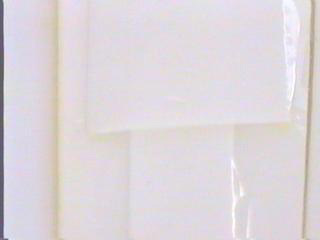 |
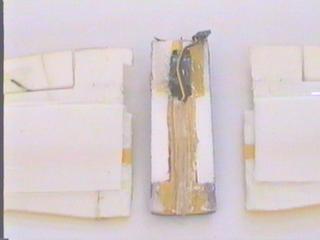 |
Aileron version requires a stiffer wing. DEPRON removes |
|
| 2" and 1" Depron strips | The 1" strip bows the 2" strip | The dihedral block is notched to accept the Depron | |
The wing is held in place with a toothpick glued into the leading edge setting into a hole in the front of the wing saddle. The rear of the wing is secured with a 1/64" Plywood blade fitting into a slot in the fuselage. The blade is secured by a pin piercing the fuselage and blade.
When you are done, you have a 109 gram plane ready to fly. It will take off and climb with 3/4 throttle. The test flight was on a mildly gusty day. But you know how it is when the plane is ready to go. A storm was on the way and I wanted to fly before it hit. Boy, was I surprised! The gusts hardly affected it! The airframe is rather clean aerodynamically so it responds like a larger plane with a higher wing loading. I was very impressed with how much control the rudder gave. The next version will have aileron control. Would you believe a 115 gram full house P-51 Mustang!
| Video of Viper |
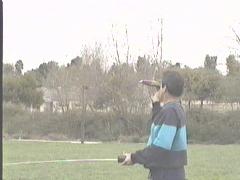 |
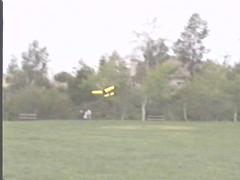 |
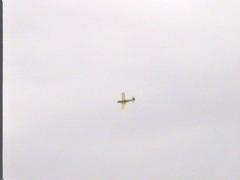 |
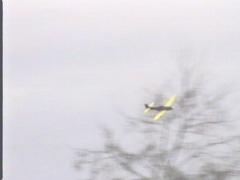 |
| 3 channels Throttle, rudder, elevator HS-50 servos SIRIUS GFS speed control GWS receiver GWS direct drive motor IPS-1BX Six cell 50-120 mah NiCd battery Stock propeller and spinner |
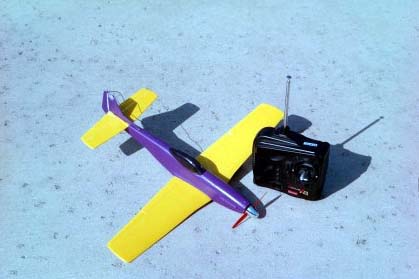 |